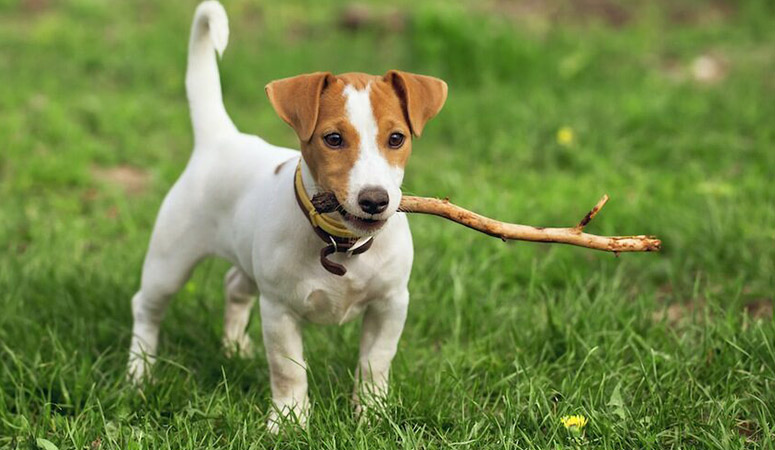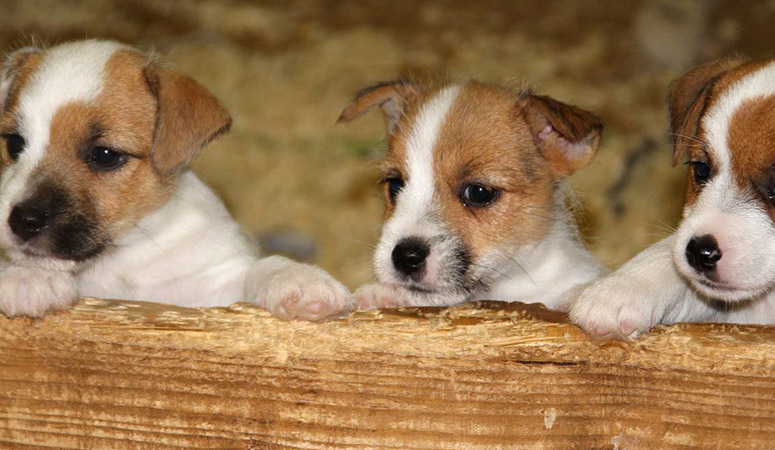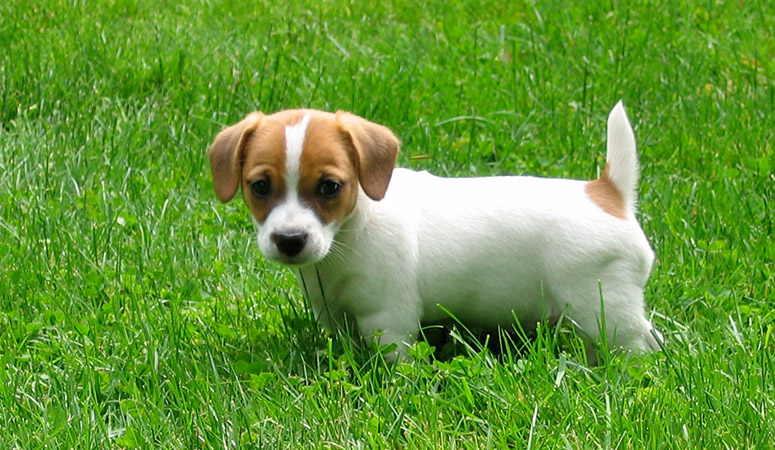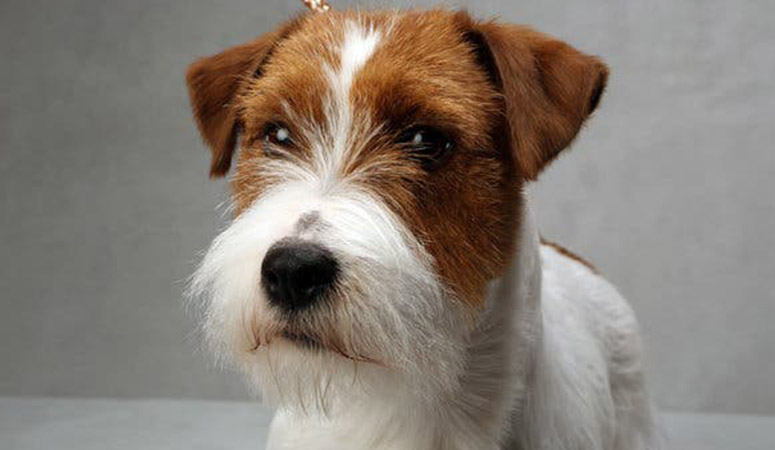Russell Terrier
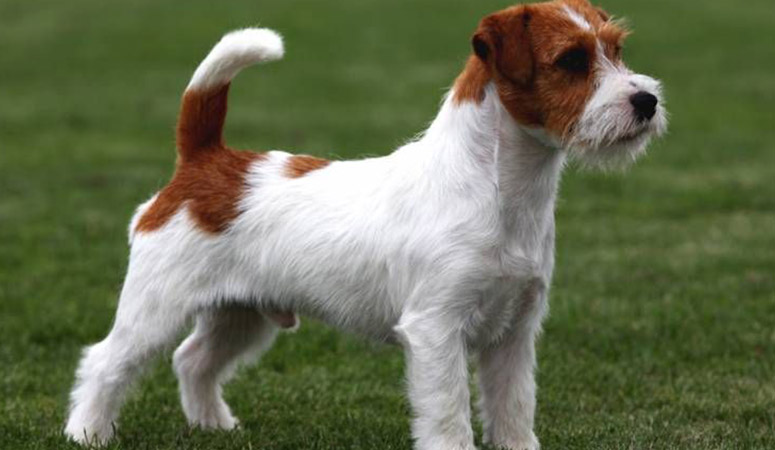
Cheerful, active, curious, and friendly, and developed in England some 200 years ago to hunt foxes, the adorable Russell Terrier looks like a plush toy but is an eager, tireless working terrier. This breed is commonly confused with the Parson Russell Terrier, and he is confident, alert, and always ready for work.
| Other Names | Jack Russell Terrier, Russell Terrier |
| Color | White, Piebald, Black & White, White & Tan |
| Height | Males: 9-13 inches. Females: 9-13 inches. |
| Weight | Males: 11-18 pounds. Females: 11-18 pounds. |
| Life Span | 12-14 years |
| Personality | Alert, Inquisitive, Lively |
| Exercise | Needs Lots of Activity |
| Origin |
| Popularity | #75 |
| Groom Needs | Weekly |
| Kids Friendly | Yes with supervision |
| Dog Friendly | Yes |
| Watch Dog | |
| Family Dog | |
| Litter Size | 4-8 |
Russell Terrier Pictures
Russell Terrier Video
Introduction
We have to get one thing straight here straight away, and that is that the Russell Terrier is not the Jack Russell terrier. There is a difference, and it has to do with their size and height. The Russell Terrier for example is shorter, at around 12 inches. The Parson Russell Terrier stands around 15 inches tall. The Russell Terrier is known as the English Jack Russell Terrier and the Irish Jack Russell Terrier in different places. However, they are in fact smaller dogs according to the Kennel Club’s definition of the Jack Russell Terriers. The Russel Terrier measures about 12 inches at the shoulder and should be longer at his withers than actually taller. He weighs about 15 pounds. He is a high-energy, active little dog this, needing regular activity. He is fearless and confident. He has a weatherproof coat that is mostly white with patches of black or tan, or both colors. Weekly brushing will keep his coat in good condition. They make good guard dogs, because they have excellent hearing, making them extra alert to what is happening around them. Also, they are alert and inquisitive, being naturally curious and observant.
Living with Russell Terrier
The rough and ready appearance of Russell Terrier is easily maintained. Their coats come in three types: smooth, broken, and rough. Brushing weekly could keep the short coat type presentable, while the rough and broken coats need going over with a brush or a dog comb weekly but are kept mostly natural, with minimal grooming. And a bath once a month or as needed could keep their coat clean and good smelling. Dental hygiene is important to this dog breed, brush your dog’s teeth at least two or three times a week to prevent tartar buildup and gum disease, and the daily brushing id better. Besides, trim the nails once a month and check the ears every week for debris or excess wax and infections.
The Russell Terrier requires several hours of physical activity each day to remain fit and well-behaved at home. The exercise for it could be in the form of a long walk or run, along with several vigorous games. Besides, they need a chance to sniff and explore in a safe place.
They are great athletes and excel in most dog sports, and their high energy levels and a robust personality make them good choices of dog breed for an outdoorsy family who wants companions when taking lots of hikes, bike rides, and long daily walks.
Generally, it is recommended to feed a Russell Terrier with one and a half to two cups of high-quality dry dog food every day, divided into two meals. More importantly, the food amount should depend on the dog’s weight, size, age, and activity level. There should be fresh and clean water at all times.
Some dogs are easy to get overweight, so you need to watch their calorie consumption and weight level all the time. Treats may be an important aid in training, but excessive intake can lead to obesity. Also, owners need to distinguish which human food is safe for dogs and which are not. If you have any problems with your dog’s weight or diet, just consult from your veterinarian.
Russell Terriers are prone to the following health conditions: Legg-Calve-Perthes disease, deafness, patellar luxation, eye conditions, including lens luxation and glaucoma, etc.
Major Concerns: Legg-Calve-Perthes disease (hip joint disease)
Minor Concerns: Knee cap dislocation
Suggested tests:
PLL DNA Test
BAER Testing
Patella Evaluation
Ophthalmologist Evaluation
Total Annual Cost: $2674
Cost is estimated for the first year and may vary depending on many factors, such as dog food, health care, leash, collar, licensing, possible fencing, crates, training and obedience classes, dog-walking, grooming, treats, toys, flea, tick, and heart-worm meds, microchips, etc.
Russell Terriers are very smart and enjoy to work on problems and play games. But they may become bored easily, the training sessions must be kept entertaining if you want them to learn. Besides, they are easy to get stubborn and distractible, so it is required patience consistency, and dog treats when training.
The athletic, lively Russell Terrier is a natural at most dog sports and agility training, and they are especially good at earthdog trials. Also, they are capable of advanced training which could help the breed’s more challenging behaviors in check.
History
This breed originated in England in the middle of the 1800s as fox and vermin hunters. They were small enough to be carried in terrier bags on horseback.
The Russell Terrier and the Parson Russell terriers do share a common heritage as fox-working dogs. Rev. John Parson Russell owned kennels, but since his day, the lines of these two terrier breeds have gone separate ways. Today they are recognized as two distinctly separate breeds.
The Russell Terrier was bred to be swift enough to run with the hounds and still be tough and compact as well.
It was in the country of development, Australia, that the Russell Terrier was standardized by the Kennel Club with the name “Jack Russell Terrier”. Unfortunately, the name was conflicting, because in the US, a terrier conforming to the Australian/FCI standard is simply called a Russell Terrier.
A dog named Paint was the first-ever Russell Terrier that was registered in the United States. Now, the Russell Terrier, like the Parson Russell Terrier, is recognized by the American Kennel Club (AKC).
Did you know that the Prince of Wales and Duchess of Cornwall released a photograph of themselves with their two dogs to mark their 15th wedding anniversary during the coronavirus lockdown? The photograph was taken of them at Balmoral estate in Aberdeenshire, Scotland, with Prince Charles holding his Russell Terrier named Beth. Camilla is seen holding another Russell Terrier called Bluebell. That just shows how popular this bundle of joy is!
Helpful Information
Breed Club: AMERICAN RUSSELL TERRIER CLUB
Breed Club Link: http://www.theartc.org/
Breed Club Rescue:

